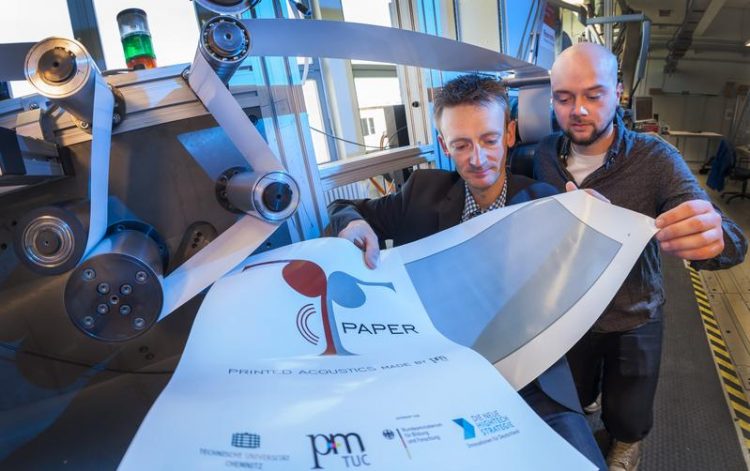Paving the way for a sounding photo book

Dr. Georg Schmidt (left) and student Robert Eland check the quality of a test print at a roll-to-roll printing press in a laboratory of the Professorship of Printed Media Technology. Chemnitz University/Uwe Meinhold
If the Institute for Print and Media Technology at the Chemnitz University of Technology succeeds, the speaker of the future will be thin as paper and make photo books and packaging sound.
In the laboratories of the Chemnitz researchers this is almost real as they already developed the numerously awarded “T-Book” – a large-scale photo book equipped with printed electronic – in 2015. If a page is turned in the “T-Book”, an invisible speaker inside the paper makes sound.
“The T-Book is a milestone in the development of printed electronics”, says Prof. Arved C. Hübler, who is managing and promoting this technology trend for 17 years and increases its global importance.
The sonorous innovation from Chemnitz is hitherto manufactured in a semi-automatic single sheet procedure. In the process, normal paper or foils are printed with two layers of conductive organic polymers as electrodes. In between, a piezoelectric layer is incorporated as active element setting the paper or foil into motion.
Thus, by air displacement the sound is produced loud and clear. Both sides of the speaker-paper can be color printed. As until now only a single sheet production is possible, the efficiency of this procedure is yet quite low.
That is why the researchers of the Institute for Print and Media Technology take a new line since May 2017 – towards the cost-efficient mass production. Aim of the current project “roll-to-roll printed loudspeaker paper” (short: T-Paper) is to transfer the hitherto single sheet production to a web-based production.
“This is supposed to significantly increase the efficiency of the complete manufacturing process in order to address future mass markets such as photo books”, explains project leader Georg C. Schmidt. Furthermore, the optimization of the performance and visual appearance of the speaker paper is planned. “Thus, the possibility arises to fully exploit the potential of the speaker paper and the extension of the application range towards, for example, the field of sensor technology”, Schmidt continues.
The project “T-Paper” is funded within the framework program “Validierung des technologischen und gesellschaftlichen Innovationspotenzials wissenschaftlicher Forschung – VIP+” of the Federal Ministry of Education and Research in the following three years with approx. 1,4 million euros.
Project website: www.tpaper.de
The movie about the T-Book developed in 2015 is available in the YouTube channel of the Chemnitz University.
Contact: Prof. Arved C. Hübler, Head of the Professorship of Printed Media Technology of the Chemnitz University, phone +49 371 531 23610, email pmhuebler@mb.tu-chmenitz.de and Dr. Georg C. Schmidt, phone +49 371 531 35175, email georg.schmidt@mb.tu-chemnitz.de
Media Contact
More Information:
http://www.tu-chemnitz.de/All latest news from the category: Materials Sciences
Materials management deals with the research, development, manufacturing and processing of raw and industrial materials. Key aspects here are biological and medical issues, which play an increasingly important role in this field.
innovations-report offers in-depth articles related to the development and application of materials and the structure and properties of new materials.
Newest articles

A universal framework for spatial biology
SpatialData is a freely accessible tool to unify and integrate data from different omics technologies accounting for spatial information, which can provide holistic insights into health and disease. Biological processes…

How complex biological processes arise
A $20 million grant from the U.S. National Science Foundation (NSF) will support the establishment and operation of the National Synthesis Center for Emergence in the Molecular and Cellular Sciences (NCEMS) at…

Airborne single-photon lidar system achieves high-resolution 3D imaging
Compact, low-power system opens doors for photon-efficient drone and satellite-based environmental monitoring and mapping. Researchers have developed a compact and lightweight single-photon airborne lidar system that can acquire high-resolution 3D…





















